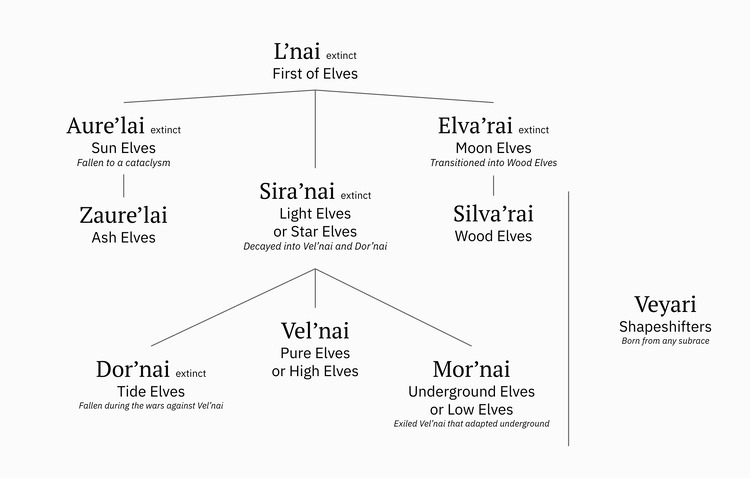Moon Elves: Difference between revisions
No edit summary |
No edit summary |
||
| (2 intermediate revisions by the same user not shown) | |||
| Line 16: | Line 16: | ||
The Elva’rai no longer exist as a distinct culture. Over generations, their descendants gradually adapted to the deep forests and, in time, became the Silva’rai, or Wood Elves. While some Silva’rai clans still preserve Elva’rai rites and stories, the original culture is considered ''dissolved'', not destroyed. | The Elva’rai no longer exist as a distinct culture. Over generations, their descendants gradually adapted to the deep forests and, in time, became the Silva’rai, or Wood Elves. While some Silva’rai clans still preserve Elva’rai rites and stories, the original culture is considered ''dissolved'', not destroyed. | ||
== Etymology == | |||
* '''Elva’rai''': Endonym; from ''elva'' (moon or reflection) and ''-rai'' (children/lineage), loosely meaning “Children of the Moon.” | |||
* '''Moon Elves''': A common name used to distinguish this lineage from other elven branches. | |||
== Elven Lineage == | == Elven Lineage == | ||
The elves of Alathra trace their origins to the L’nai, the First Elves—primordial beings of long life, arcane potential, and fluid essence. Over the ages, the L’nai gave rise to multiple branches through divergence in philosophy, environment, and magical affinity. | The elves of Alathra trace their origins to the L’nai, the First Elves—primordial beings of long life, arcane potential, and fluid essence. Over the ages, the L’nai gave rise to multiple branches through divergence in philosophy, environment, and magical affinity. | ||
From the L’nai emerged the Aure’lai (Sun Elves), Sira’nai (Star Elves), and Elva’rai (Moon Elves), who formed the three great ancient lineages. Each of these lines would, in time, fragment further into the modern elven subraces of today: the imperial Vel’nai (High Elves), exiled subterranean Mor’nai ( | From the L’nai emerged the Aure’lai (Sun Elves), Sira’nai (Star Elves), and Elva’rai (Moon Elves), who formed the three great ancient lineages. Each of these lines would, in time, fragment further into the modern elven subraces of today: the imperial Vel’nai (High Elves), exiled subterranean Mor’nai (Underground Elves), extinct seaborne Dor’nai (Tide Elves), forest-bound Silva’rai (Wood Elves), and the remote Zaure’lai (Ash Elves). | ||
Scattered among all lineages are the rare Veyari, shapeshifters born with residual echoes of the L’nai essence. Though rare, they are found across all elven communities and maintain no distinct homeland of their own. | Scattered among all lineages are the rare Veyari, shapeshifters born with residual echoes of the L’nai essence. Though rare, they are found across all elven communities and maintain no distinct homeland of their own. | ||
[[File: | |||
[[File:Elven Race Lineage.png|frameless|750x750px]] | |||
Latest revision as of 06:42, 16 July 2025
| Moon Elf | |
|---|---|
| Major race | |
 Example appearance | |
| Attributes | |
| Average lifespan (max) | 1200 years (1600) |
| Age of maturity | 300 years |
| Height range | 1.75 - 2.20 m (5′9′′ - 7′30′′) |
Parent Race: Elf
Note: The Moon Elves are considered an ancient race. While their descendants, the Wood Elves, still carry fragments of their legacy, Moon Elves should not be used as a playable race by new characters.
The Moon Elves, or Elva’rai, were a semi-nomadic elven minor race directly descended from the First Elves (L’nai), and were considered the most nature oriented elven civilization in the early ages. Originating from the lost continent of Aurel, they withdrew into forested peripheries, aligning their lives with the lunar cycle, natural rhythms, and shadow magic. Their society emphasized community, detachment, and nature conservation, serving as the primary shapers of ancient healing traditions.
The Elva’rai built no grand cities, left behind few formal archives, and developed no central governance. Instead, their cultural cohesion rested in ritual, oral memory, and a sustained relationship with nature—particularly forests, shadows, and the moon.
Though often overshadowed by their more dominant kin, the Elva’rai held influence in early elven spiritual traditions and are widely credited with preserving ancient healing practices long after other lineages formalized or fractured.
The Elva’rai no longer exist as a distinct culture. Over generations, their descendants gradually adapted to the deep forests and, in time, became the Silva’rai, or Wood Elves. While some Silva’rai clans still preserve Elva’rai rites and stories, the original culture is considered dissolved, not destroyed.
Etymology
- Elva’rai: Endonym; from elva (moon or reflection) and -rai (children/lineage), loosely meaning “Children of the Moon.”
- Moon Elves: A common name used to distinguish this lineage from other elven branches.
Elven Lineage
The elves of Alathra trace their origins to the L’nai, the First Elves—primordial beings of long life, arcane potential, and fluid essence. Over the ages, the L’nai gave rise to multiple branches through divergence in philosophy, environment, and magical affinity.
From the L’nai emerged the Aure’lai (Sun Elves), Sira’nai (Star Elves), and Elva’rai (Moon Elves), who formed the three great ancient lineages. Each of these lines would, in time, fragment further into the modern elven subraces of today: the imperial Vel’nai (High Elves), exiled subterranean Mor’nai (Underground Elves), extinct seaborne Dor’nai (Tide Elves), forest-bound Silva’rai (Wood Elves), and the remote Zaure’lai (Ash Elves).
Scattered among all lineages are the rare Veyari, shapeshifters born with residual echoes of the L’nai essence. Though rare, they are found across all elven communities and maintain no distinct homeland of their own.
